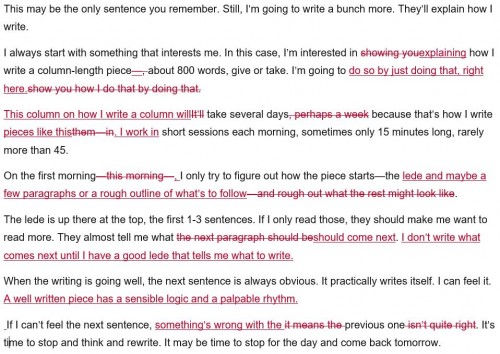The first three posts in this series are here, here, and here. This post reflects review comments and edits suggested by Ishani Ganguli.
This sentence should make me want to write the next one. It should make you want to read it. In a nutshell, that’s my best answer to a question I receive frequently: “How do you write?”
When I begin a new Upshot-styled piece, my ambition is only to figure out how it starts—the first few sentences or the lede. I don’t write anything else until I have a good lede, one that almost compels me to write more. I can spend as long on the first three sentences as on the next thirty. (Many others prefer to initially dump their thoughts to the page for later refinement and organization. That’s fine. It’s just not my approach.)
When the writing is going well, the next sentence practically writes itself. A well written piece has a sensible logic and a palpable rhythm. If I can’t feel the next sentence being pulled out of me, something’s wrong with the previous one. It’s time to stop, think, and rewrite. It may be time to stop for the day and try again later.
When I return to my draft, I always read it from the top and edit as I go. On the second day of working on this piece, here’s how I revised the first few paragraphs. (I’ve revised them further since then.)

Each paragraph is a thought. As is any good sequence of thoughts, they should be logically ordered. I usually make the logic plain by including in the first sentence of each paragraph something that links to the prior one. One word in common is often enough. For example, the second paragraph ends with a mention of sentences. The first sentence of the third paragraph includes “… the next sentence …” The writer (and the reader) is propelled from one thought to the next.
Writers worth emulating, like Atul Gawande and Lisa Rosenbaum, break this rule sometimes. From them I’ve learned that it’s OK to broach a new thought abruptly. Until the relevance of the new thought is fully revealed—which should be rather quickly—it adds tension and intrigue. (An example is found two paragraphs below.) It works as long as it isn’t over done.
There are few sentences that can’t be improved by shortening them. The periods in between allow the reader to rest, to consolidate thoughts. I almost always revise to shorten, not lengthen. Still, a longer sentence is worthwhile if it prevents the reader from resting prematurely—before I’ve conveyed enough to be understood.
On assignment, writer and writing teacher William Zinsser once traveled to Timbuktu to see the salt caravan. In On Writing Well, he described how he wrote about it. His process included an hour-long search for the right words for just one sentence. This type of effort is worth it, though I usually don’t let the wrong word halt my progress for that long. Instead, I take notice of less-than-perfect words as I write and think about them later. An early draft of the third paragraph included “A well written piece has a clear logic and a precise rhythm.” I knew when I wrote them that “clear” and “precise” were lazy, tired, cliché—wrong. I even wrote them in bold, underline, italics, which is how I signal to myself that I need come back and revise.
On a walk, I came up with the revision: “sensible logic and a palpable rhythm.” For so many reasons, I prefer “sensible” and “palpable” to “clear” and “precise.” They feel fresh. They also rhyme. Best of all, “palpable” exactly conveys my sense of feeling the right, next sentence. In one word, it makes my point. It must be right.
My secret weapon is writing well ahead of deadlines. I’m not a procrastinator. This leaves plenty of time to find better words, among other refinements. When searching for words, I prefer ones I know well and feel like me. But I’m always on the lookout for new ones that I might grow into. I recall trying out “fealty” and “attendant” (as an adjective), for example. They still don’t feel like my voice, but maybe someday. Then again, maybe not. I can’t imagine ever writing “crestfallen.”
When my full draft is written, I like to get it reviewed by a subject-matter expert to check my facts and reasoning. I always pick someone I think is likely to be interested in serving this role, like an author I cite. This piece was reviewed by Ishani Ganguli.
A piece of this length should have one main point. What is it? The lede tells you. I want to make sure that point appears in the concluding paragraph too. This is a useful trick. If you can’t figure out how to end a piece like this, go back and see how you started it. If the first few sentences are right, the rest of them come more easily, including the last.


